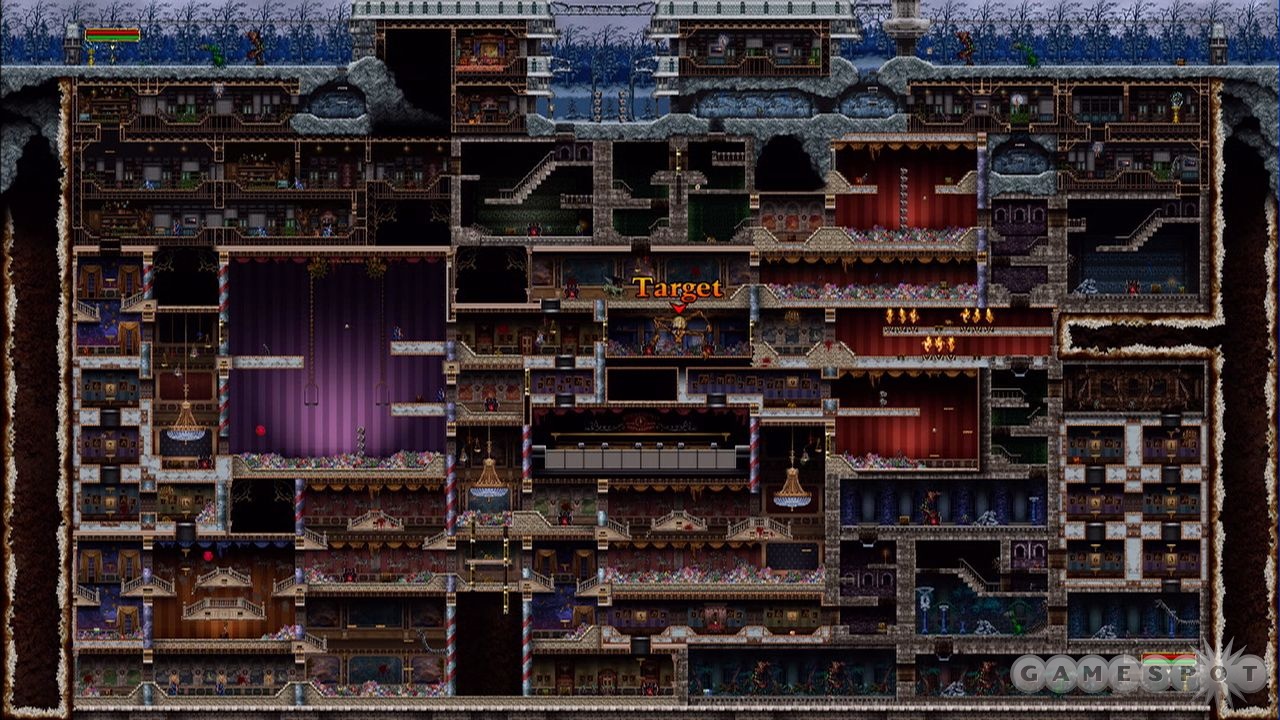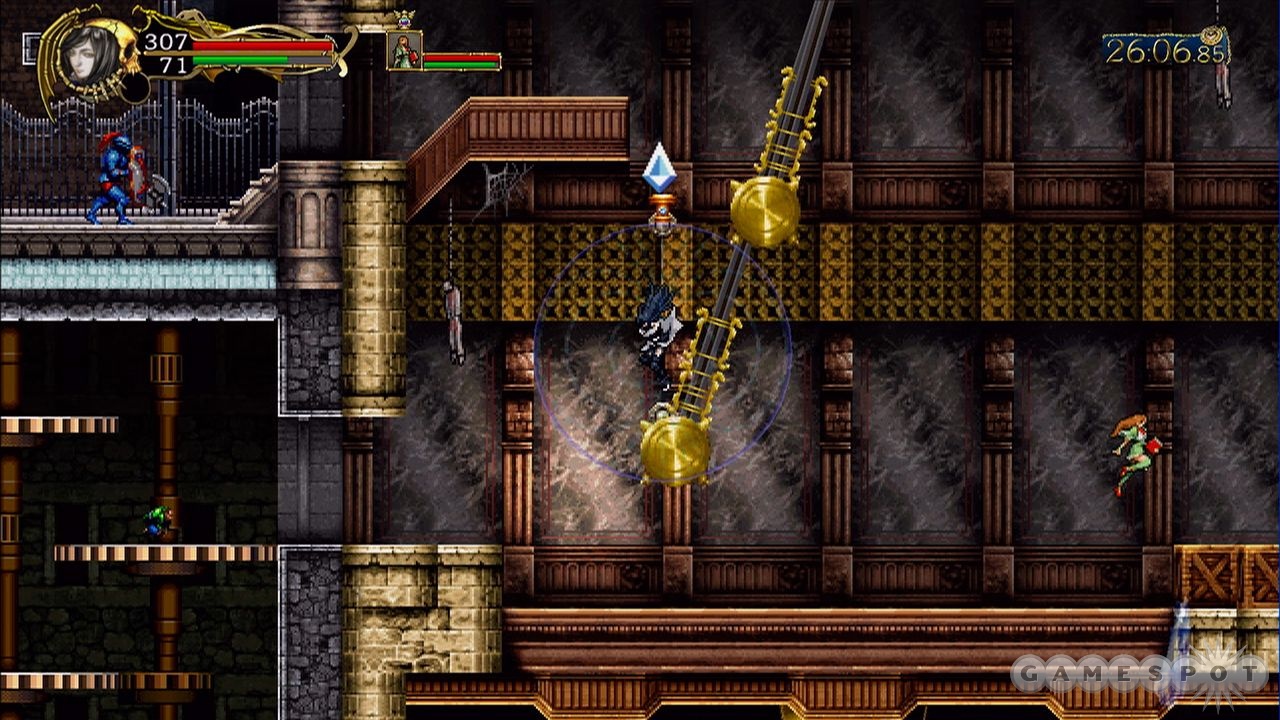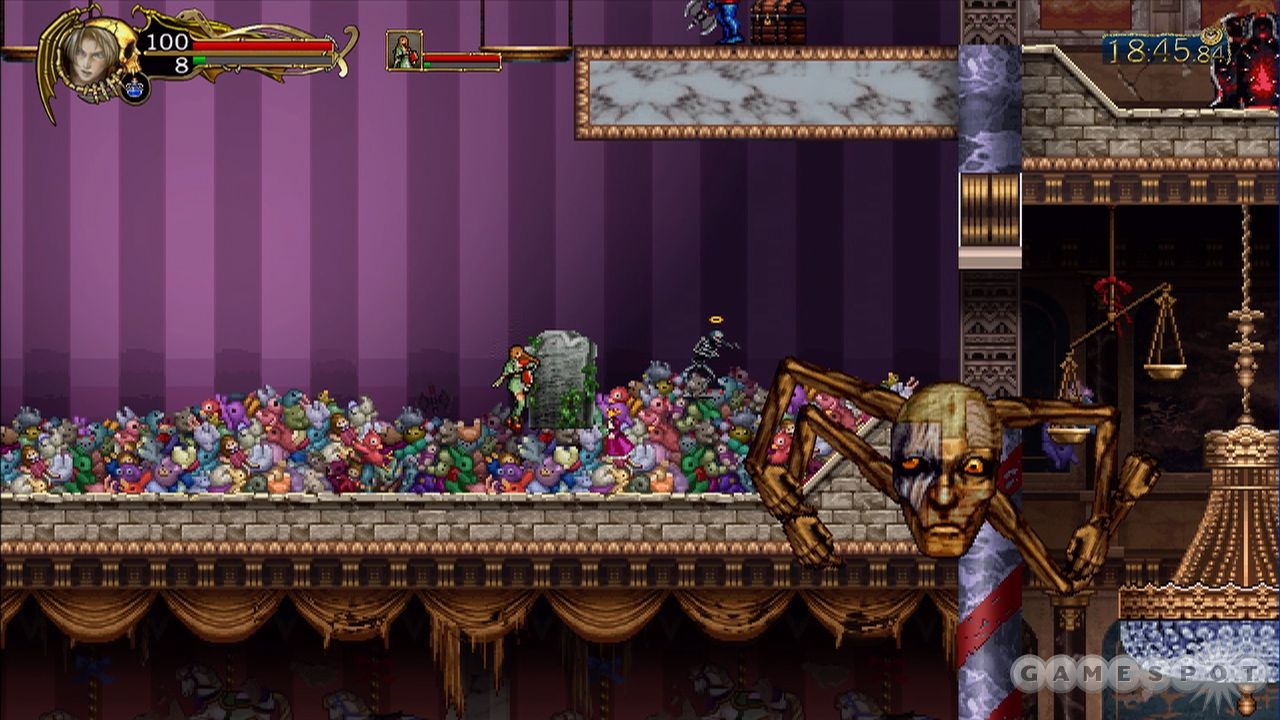Cooperative play probably isn't the first thing that comes to mind when reflecting on Castlevania--a series that built an identity around solitary adventures through a single, massive castle. Some ardent fans may even consider the major integration of such a feature sacrilegious, something that breaks Castlevania's fundamental appeal. But, like it or not, cooperative play (that supports up to six players) is the crux of Castlevania: Harmony of Despair. There’s not much evidence to suggest that such a formula should work or provide any semblance of entertainment beyond that of staring at a train wreck, but Harmony of Despair delivers a fun, new, interesting approach to a franchise that has largely followed the same rubric for years..
That's not to say that much of the game won't feel immediately familiar to those who have played the last few Nintendo DS games or the PlayStation classic, Symphony of the Night. In fact, much of Harmony of Despair--from the characters to the maps--is a Frankenstein monster of sorts, selecting various visual and gameplay elements from those games and melding them into a cohesive experience. Accordingly, you have the option to select from five characters from previous Castlevania outings: Soma Cruz, Alucard, Jonathan Morris, Shanoa, and Charlotte Aulin. These characters have skills and abilities unique to the game they appeared in.
Alucard can still change forms and can find spells to complement his strong melee attacks, whereas Shanoa relies heavily on magic attacks that she can steal from enemies by absorbing their glyphs. Charlotte can learn new spells by blocking enemy projectiles with her special shield, and Jonathan Morris can learn new martial arts skills that are dropped by enemies upon defeat. The same applies to the traditional Castlevania subweapons he can use. What's great about these characters is that they all have distinct strengths and weaknesses that balance out when you're playing cooperatively. Alucard may have strong melee attacks, but since his magic attacks are relatively weak, he's not that effective at a distance. But when he's partnered up with characters who are more proficient with magic, the combination is devastating. Still, don't expect to just waltz through Harmony of Despair's six levels--even when playing cooperatively. The game is hard, and it knows it's hard.
Therefore, death is an intentionally common occurrence, but it's not an entirely frustrating one thanks to the surprisingly addictive way Harmony of Despair handles character growth. To put it simply, it's all about grinding, but you're not doing it in the traditional sense of defeating enemies and earning experience points to level up. Characters do have individual stats, but these can be changed only by purchasing weapons, items, or armor from the store or finding them in treasure chests scattered throughout a level (special items can also be found by simply defeating enemies). Since the money you earn in a level carries over even after death, you can grind for additional funds and then use them to procure stronger items that will help get you through a level. You can do the same for items not found in the store like new martial arts skills or subweapons for Jonathan, more magic spells for Charlotte and Shanoa, or more souls for Soma.

This might all seem like a supremely tedious experience, but there are a few things at work in Harmony of Despair that counterbalance the repetition. The first is that the grinding has an immediate payoff, at least in terms of money. Purchasing new armor or weapons (for those who can equip weapons) is a quick way to beef up your character enough to take on the boss of a level. Magic users aren't quite as fortunate since their spells are typically limited to the enemies they have access to, but even then, finding a new spell in a level can make all the difference in a fight. The second is the way the levels are structured. Since these aren't the same huge castles from previous Castlevania games (they're more like mini-castles), it's a bit easier to entertain the idea of playing through an entire level over again. Plus, it's also worth mentioning that you can easily plot an initial course to the boss by viewing the entire map (performed by clicking in the right analog stick), and once you've found an easy route, it takes very little time to go from the start to the end.
Time is another important component of Harmony of Despair and another affront to the Castlevania games of the last few years. You have 30 minutes to complete each level. If one of your teammates happens to die, they transform into a skeleton, which allows them to move around and continue attacking. But if they die while in skeleton form, the countdown goes even faster. Teammates can revive fallen comrades by using the water of life, but sometimes that's easier said than done when players are scattered across the map or if there is no water of life to be found in a level. Moreover, pausing the game doesn't stop the clock, nor does the equip screen that you can access through special books placed at various points in a level. At any rate, when the clock hits zero, the game ends. Still, because of the bite-sized nature of the levels, it's not as frustrating as it sounds, and time hardly factors into the equation when you know the correct route.

There are some areas where Harmony of Despair falters. Some of the visual elements used in this game are well over 10 years old, and the attempt to shoehorn the visual style of numerous Castlevania games into one package only enhances its Frankenstein monster-like nature, particularly when it comes to the level of detail (or lack thereof) in the characters. The environments look fine, but absolutely nothing was built from the ground up for the Xbox 360, so everything generally has a gritty, pixelated look that can make things difficult to see unless you're sitting close to the TV. The music is passable guitar-heavy stuff--with some remixed Castlevania tunes included--but there's nothing that really stands out. Controls feel a bit too loose at times with jumps, attacks, or spells not coming out when you want them to. They feel more friendly as you progress through the game, but these controls aren't as razor sharp as those found in the previous incarnations of the series.
Even with those complaints, Despair's most egregious failure is how it presents information related to how to play the game properly and what different things mean in context of gameplay. There is an in-game manual that gives basic information, but neither that nor the character equip menus go into enough detail to explain how certain things work, or they're simply not clear enough. How long does it take to capture spells? Can this character use different weapons? Is that spell really leveling up? These are questions you'll be asking yourself often. Of course, if you've played the last few Castlevania games, you should have no problem, but if you've been out of the loop since Symphony of the Night, you'll find yourself tinkering with characters for quite some time in an attempt to learn on your own. The game's Survival mode, which pits you against other players in a deathmatch arena of sorts, is a good place to see how your skills stack up and if you're missing anything particularly noteworthy about your character, but overall, the game is in dire need of some proper documentation.

There are many smaller things that seem frustrating initially but that make more sense the more you play the game. For example, not having access to your health items at all times--they can be accessed only before you start the level or by finding an equip point, and even then, you can equip only one type. But if you were able to use them at any time without equipping them, Harmony of Despair would be a much easier game. Along those same lines, other multiplayer grinding tropes, such as sharing items, weapons, and armor, would also make the game far easier, because stronger players could simply give their best equipment to a teammate. Part of this game's charm is building up your character and handily beating the boss, only to move to the next level to be thoroughly beaten down by a new boss. Of course, there are some instances when Harmony of Despair caters more to the multiplayer cooperative experience than the single-player. For instance, most of the secret areas can be accessed only with other players, but in reality, that's the best way to experience this new Castlevania, and it's the optimal way to experience what may be a new and fun potential direction for the series to take.